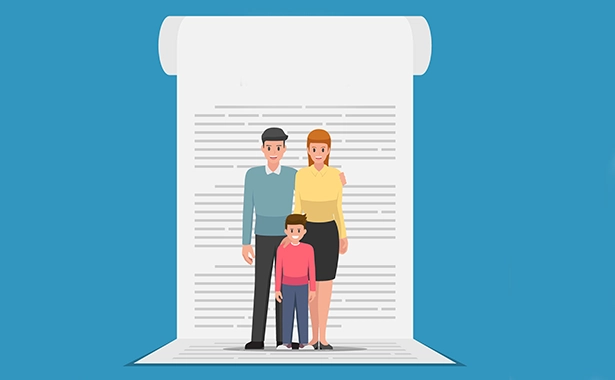Contents
Temporary custody orders are a core part of family law cases. They decide where a child will live, residential placement, who makes important decisions, and how parenting time is shared during the case. Courts treat these orders as fully enforceable: violations can result in contempt findings, sanctions, or later modifications. Even though they are temporary, these orders often establish the day-to-day arrangements that shape the outcome.
In the United States, temporary custody primarily arises under state statutes and is governed by the Uniform Child Custody Jurisdiction and Enforcement Act (UCCJEA). In Canada, practitioners must navigate both federal jurisdiction under the Divorce Act and provincial or territorial legislation. Across both systems, the governing standard remains the best interests of the child, but evidentiary thresholds, procedural safeguards, and statutory frameworks diverge. Effective advocacy at this stage requires procedural fluency and strategic foresight.
What this guide will equip you to do:
- Understand the legal foundations of temporary custody in both the U.S. and Canada.
- Analyze how courts apply the best interests of the child standard in interim proceedings.
- Navigate jurisdictional requirements, including the UCCJEA and Canadian federal–provincial rules.
- Distinguish between standard and emergency (ex parte/urgent) applications.
- Draft enforceable temporary orders addressing custody, parenting time, and support.
- Address litigation complexities, including allegations of abuse, parental fitness issues, and expert involvement.
- Enforce and modify temporary orders through contempt or variation proceedings.
- Evaluate the strategic impact of interim rulings on final custody determinations.
Together, these areas form the core of effective custody litigation practice. By approaching temporary custody with the same rigor applied to final hearings, practitioners can secure immediate protections for children, preserve favorable positions for their clients, and influence the trajectory of the case long before trial. The sections that follow examine these issues in detail, outlining statutory frameworks, procedural pathways, evidentiary strategies, and enforcement mechanisms in both U.S. and Canadian jurisdictions.
The Interim Legal Framework of Temporary Orders
Following separation, the court often issues a Temporary Child Custody Order as its first intervention. This order stabilizes the child’s environment by imposing structure and predictability during litigation. For practitioners, understanding and applying these interim measures is central to effective custody advocacy.
These orders appear under different terms. In the United States, they are often referred to as Temporary Custody Orders or Pendente Lite Orders, meaning pending litigation. In Canada, they are known as Interim Parenting Orders. Regardless of the terminology, they are legally binding mandates that establish custody and parenting arrangements until a final judgment is rendered. They serve as a bridge between the initial filing and the conclusion of the case, which can take months or years, depending on the complexity.
The legal effect of a temporary order mirrors that of a final order during its existence. Courts enforce them fully and impose penalties for violations, including contempt findings, financial sanctions, and, in severe cases, incarceration. Their enforceability compels compliance and protects the child’s stability while proceedings continue.
The central purpose of a temporary order is to provide stability during disruption. By setting residence, visitation schedules, and decision-making responsibilities, the order minimizes parental conflict and secures consistent care. Courts rely on the concept of the status quo, preferring continuity in the child’s school, community, and caregiving arrangements. This principle has a significant strategic effect. The parent who establishes stability at the outset often gains a litigation advantage, as courts hesitate to alter functioning arrangements at the final hearing.
Although temporary orders are distinct from final judgments, they often determine the case trajectory. A temporary arrangement that proves effective can strongly influence final rulings, since the opposing party must argue to disrupt an established and stable environment. The temporary hearing, therefore, operates as a decisive stage rather than a preliminary step.
The scope of relief available in a temporary order is broad. Orders commonly include:
- Physical custody: Establishes the child’s residence and a detailed parenting schedule. Provisions cover weekdays, weekends, holidays, vacations, transportation duties, and communication protocols. In Canadian law, this is referred to as parenting time.
- Legal custody: Assigns authority for major decisions involving education, health care, and religion. In Canadian terminology, the decision-making responsibility is.
- Ancillary matters: Addresses related issues such as temporary child support based on parenting schedules, interim spousal support, exclusive use of the marital residence, and allocation of household expenses.
Temporary and final orders differ in duration, evidentiary basis, and standards for modification. Courts issue temporary orders on limited records, often relying on affidavits and brief testimony. Final orders are issued following a full trial, with comprehensive evidence and thorough cross-examination. Modification of temporary orders requires a showing of changed circumstances, while altering a final order usually demands proof of a substantial and continuing change.
Procedural Pathways to Obtaining a Temporary Order
The law provides two main procedural mechanisms for securing Temporary Child Custody Orders. The first is the standard motion process. The second is the emergency or ex parte process. Each pathway carries a distinct evidentiary burden, reflecting a balance between due process and child protection.
The Standard Motion for Temporary Orders
The standard pathway begins with a formal application to the court. This process guarantees notice and an opportunity to be heard before custody arrangements are imposed.
Initiating the Action
The moving party files a Motion for Temporary Orders, an Application for an Interim Order, or an Order to Show Cause. The motion must include an affidavit or declaration that sets out the factual background, the relief requested, and the argument in support of the best interests standard. A proposed parenting plan should accompany the filing. If financial support is at issue, most courts require a sworn financial disclosure.
Service and Response
Due process requires service of the motion and supporting documents on the opposing parent. The respondent has a fixed time period under court rules to file a written response, often supported by a counter-affidavit and sometimes by a cross-motion seeking alternative relief.
The Role of Mediation
Many jurisdictions mandate mediation before a contested hearing. Courts will not hear motions until parents attempt to resolve disputes through a neutral mediator. This requirement reflects judicial policy favoring cooperative parenting arrangements.
The Hearing
If mediation fails, the court schedules a hearing. Hearings are brief, often limited by strict time controls, and less formal than trials. Judges review sworn affidavits, documentary exhibits, and limited live testimony. Based on the compressed record, the judge issues an interim order consistent with the child’s best interests.
Emergency and Ex Parte Applications
Emergency applications address imminent threats to a child’s safety. Courts may hear these matters on an ex parte basis, without notice to the opposing parent.
The Legal Standard: Immediate and Irreparable Harm
The moving party must present sworn evidence of immediate danger of physical or emotional harm, or a credible risk of abduction. This standard is far higher than the general best interests test. Courts grant such relief only with clear, convincing evidence of a genuine crisis.
Grounds for Emergency Relief
Courts recognize narrow categories that justify emergency orders, including:
- Credible allegations of physical or sexual abuse
- Severe and untreated substance abuse that endangers the child
- Acute mental health crises render a parent incapable of care
- Credible threats of abduction, such as one-way international travel arrangements or asset liquidation
The Ex Parte Process
Judges may grant relief based solely on the applicant’s motion and affidavit. Courts often review emergency requests the same day. The process is unilateral and reserved for circumstances where providing notice could increase the risk of harm to the individual.
Follow-Up Hearing and Due Process
Ex parte custody orders are short-lived, often limited to 10 to 21 days. Courts must immediately schedule a follow-up hearing at which both parents are required to appear, present evidence, and present their respective positions. This restores due process while ensuring child protection in the interim.
Balancing Principles
The standard motion process preserves notice and bilateral hearing rights. The emergency pathway temporarily suspends these rights under the doctrine of parens patriae to protect children from immediate harm. Courts set a high evidentiary threshold and require a prompt review hearing to re-establish procedural fairness. For practitioners, success on emergency motions requires not only proof of danger but also a persuasive showing that the danger is so imminent it justifies temporary suspension of the other parent’s rights.
The Judicial Standard: The Best Interests of the Child Doctrine
The best interests of the child doctrine governs every custody determination in the United States and Canada. It is flexible and discretionary, directing the court to identify the arrangement that best secures the child’s long-term welfare. While the principle is universal, its application depends on fact-specific statutory factors and judicial discretion.
Deconstructing the Best Interests Test
The doctrine places the child’s welfare above parental rights. Courts craft orders that promote the child’s physical, emotional, and psychological development. International law reinforces this principle. The UN Convention on the Rights of the Child, influential in Canadian courts, requires that the child’s best interests be the primary consideration in custody outcomes.
Statutes list factors to guide courts, but these lists are non-exhaustive. Judges may consider any relevant circumstance. The common characteristics include:
- Parental fitness and capacity: Ability to provide food, shelter, medical care, guidance, and emotional support. Courts also review a parent’s mental and physical health, but only as it affects their ability to care for their children.
- History of violence or abuse: Proven family violence or neglect weighs heavily against a parent. Many jurisdictions hold that evidence of abuse rebuts presumptions favoring joint custody.
- Child’s relationships: Courts evaluate emotional bonds with parents, siblings, extended family, and other significant individuals.
- Continuity and stability: Judges favor preserving the child’s routines, community ties, and established caregiving arrangements.
- Parental cooperation (friendly parent factor): Courts examine the willingness to support the child’s relationship with the other parent. Attempts to obstruct or undermine that relationship harm a parent’s case.
- Child’s preference: Courts may consider the views of a mature child. The weight depends on age and reasoning. In some jurisdictions, such as Georgia, a 14-year-old’s preference is presumed to be valid unless the chosen parent is deemed unfit to act in the child’s best interests.
- preference is presumed to be valid unless the chosen parent is deemed unfit to act in the child’s best interests.
The standard’s breadth gives judges broad discretion. Custody litigation becomes less about strict legal rules and more about persuasive narratives. Attorneys must align the client’s conduct with the statutory factors and judicial priorities.
Litigation strategy requires building a coherent story. Counsel should marshal evidence such as attendance at medical appointments, involvement in schooling, and support for the child’s extended family connections. The goal is to present the client as the parent who best embodies the child’s interests. Well-organized and credible evidence, combined with effective advocacy, often determines the outcome.
Comparative Analysis of Best Interests Factors
To provide practitioners with a practical tool for navigating different legal landscapes, the following table offers a side-by-side comparison of the statutory “best interests” factors in several key U.S. and Canadian jurisdictions. This highlights both the common themes and the unique points of emphasis in each legal system.
FactorTexas (Holley Factors)FloridaGeorgiaCanada (Federal Divorce Act & Provincial Principles)
Child’s PreferenceThe desires of the child.The reasonable preference of the child, if the court deems the child to be of sufficient intelligence, understanding, and experience to express a preference.The child’s selection is presumptive if 14 years or older; considered if between 11 and 14.The child’s views and preferences, giving due weight to the child’s age and maturity. The UN Convention, influential in Canada, mandates the child be given an opportunity to be heard.
Parental Health The emotional and physical needs of the child now and in the future; emotional and physical danger to the child now and in the future. The mental and physical health of the parents. The mental and physical health of each parent. The health and emotional well-being of the child. Parental conduct is considered only as it affects the ability to parent. Domestic Violence Acts or omissions of the parent that indicate the existing parent-child relationship is not a proper one; history of family violence. Evidence of domestic violence, sexual violence, child abuse, child abandonment, or child neglect. Any evidence of family violence or sexual, mental, or physical child abuse or criminal history of either parent. Family violence must be taken into account. The protection of the child from abuse and neglect is a primary consideration. Stability/Continuity The stability of the home or proposed placement. The demonstrated capacity of each parent to provide a consistent routine for the child. The desirability of maintaining continuity. The importance of continuity in the child’s life and the length of time the child has lived in a stable, satisfactory environment. The child’s existing routine and ties to their school and community are key considerations for stability. Primary Caregiver The parental abilities of the person seeking custody. The division of parental responsibilities and tasks performed by each parent. Each parent’s past performance and relative abilities for future performance of parenting responsibilities. The court considers who has been the primary caregiver and each parent’s past involvement in the child’s life. Willingness to Co-parent The plans for the child made by the person seeking custody. The demonstrated capacity and disposition of each parent to facilitate and encourage a close and continuing parent-child relationship between the child and the other parent. The willingness and ability of each of the parents to facilitate and encourage a close and continuing parent-child relationship between the child and the other parent. The “friendly parent” principle is a key factor; the willingness of a parent to support the child’s relationship with the other parent is considered. This comparative table serves as a quick-reference guide, allowing a practitioner to rapidly identify the specific legal tests they must meet in a given jurisdiction. It highlights which jurisdictions place more explicit statutory weight on certain factors, thereby informing case strategy and client counseling. For cross-border cases, this analysis is fundamental to advising a client on which jurisdiction may offer a more favorable legal environment and how to best frame arguments to meet that jurisdiction’s specific criteria.
Litigation Strategies for the Temporary Custody Hearing
Success in a temporary custody hearing depends on preparation, disciplined execution, and a clear understanding of the evidentiary framework in family court. This section outlines litigation strategies that enable practitioners to convert legal analysis into effective courtroom advocacy.
Pre-Hearing Preparation
Preparation before the hearing determines the outcome. A well-organized case presents credibility and clarity, which facilitates judicial adoption of proposed relief.
Client Counseling and Management
The attorney-client relationship must rest on candor. Counsel must require complete disclosure of facts, including adverse information, because opposing parties will exploit undisclosed weaknesses. Advance knowledge permits a strategic response and prevents credibility loss at the hearing. Clients must frame requests in terms of the child’s needs, avoid involving children in conflict, and refrain from attempting to influence the child’s stated preferences.
Evidence Gathering and Organization
Effective presentation depends on a structured evidentiary record.
- Affidavits and Declarations: Sworn statements constitute the principal evidentiary submission. They must provide a coherent, factual narrative that establishes parental involvement, parental fitness, and the reasons why the requested orders serve the child’s best interests.
- Documentary Exhibits: Relevant documents such as correspondence, school and medical records, photographs, and financial statements must be compiled, organized, and pre-marked. Providing exhibit lists to the court and opposing counsel demonstrates preparation and conserves hearing time.
- Witness Preparation: Although testimony is often limited, any witness presented must be fully prepared. Counsel should select only the witness who offers the most credible and probative testimony.
- Parenting Plan Development: The moving party must propose a detailed plan addressing residential schedules, holidays, transportation, decision-making, and communication. A comprehensive plan provides the court with an immediately enforceable template.
- Compliance with Local Rules: Local rules often restrict the length of hearings, impose page limits, and require the use of specific forms. Failure to comply can result in procedural rejection or prejudice to the applicant. Counsel must review and adhere strictly to all applicable rules.
Conduct of the Hearing
Execution requires discipline, credibility, and precision.
Credibility
Judges frequently resolve conflicting affidavits based on their perception of credibility. Counsel must advise clients to admit minor mistakes rather than deny verifiable facts. Demonstrations of insight and self-awareness enhance credibility more than presenting an implausible record of perfection.
Focus and Efficiency
Strict time limits necessitate a focus on the most persuasive issues. Counsel must identify one or two dispositive points and build the argument around them. A concise written summary of the requested relief should be provided to the court at the outset. Simple visual aids, such as photographs of the child, may underscore the client’s position without wasting time.
Strategic Objective
The primary goal is to establish a stable arrangement that aligns with the child’s best interests. If the order functions effectively, it becomes the de facto status quo, which opposing parties will struggle to dislodge at trial. The temporary hearing is not a rehearsal but a compressed adjudication. Counsel must apply the same advocacy tools as in trial—narrative control, evidentiary precision, and procedural compliance under severe time constraints.
Evidentiary Considerations
Family courts apply evidentiary rules with flexibility at the temporary stage, but practitioners must still understand and apply foundational standards.
Standard of Proof
In Canada, the moving party bears the burden of proof on a balance of probabilities, while in the United States, it is a preponderance of the evidence.
Hearsay
Hearsay, defined as an out-of-court statement offered as evidence of its truth, is generally inadmissible. Temporary custody hearings, however, often rely on affidavit evidence, which consists mainly of hearsay. Courts permit this departure to accommodate the need for expedited relief.
Child’s Statements
Courts admit out-of-court statements of children through established exceptions. In Canada, the R. v. Khan case framework permits admission where necessity and reliability are demonstrated. Necessity is met when direct testimony would traumatize the child. Reliability is assessed through the circumstances of the statement, including timing, demeanor, capacity, and absence of motive to fabricate. This approach allows courts to consider the child’s perspective without exposing the child to adversarial testimony.
Navigating Jurisdictional Complexities
Custody litigation frequently crosses state and national borders. A court must establish jurisdiction before adjudicating the case on its merits. Jurisdiction is the legal authority to hear a case and issue a binding order. Jurisdictional statutes are designed to prevent conflicting rulings and deter forum shopping. For practitioners, jurisdictional challenges often represent the first and most consequential stage of interstate or international child custody litigation.
U.S. Interstate Jurisdiction under the UCCJEA
The Uniform Child Custody Jurisdiction and Enforcement Act (UCCJEA), adopted by 49 states, the District of Columbia, Guam, and the U.S. Virgin Islands, provides a uniform system for resolving interstate custody disputes. The Act governs legal custody, physical custody, and visitation, including temporary orders. Its primary objectives are to prioritize the child’s home state, clarify modification authority, and establish enforcement mechanisms across state lines.
The UCCJEA creates a hierarchy of jurisdictional bases:
- Home State Jurisdiction: A state qualifies as the home state if the child lived there with a parent for at least six consecutive months before the commencement of proceedings, or since birth if younger than six months. The Act preserves extended home state jurisdiction for six months after relocation if one parent remains in the original state.
- Significant Connection Jurisdiction: Available when no state qualifies as the home state or when the home state declines jurisdiction. The child and at least one parent must maintain significant ties to the state, and substantial evidence concerning the child’s care must be available in that residence.
- More Appropriate Forum and Vacuum Jurisdiction: Fallback provisions apply when states with primary jurisdiction decline to act or when no state satisfies the preceding tests.
The Act authorizes Temporary Emergency Jurisdiction. A state where the child is physically present may issue a temporary order if the child has been abandoned or requires immediate protection due to mistreatment or abuse. Emergency jurisdiction stabilizes the situation until the state with proper long-term jurisdiction acts.
The UCCJEA also establishes Continuing Exclusive Jurisdiction. Once a court issues an initial custody determination consistent with the Act, it retains exclusive authority to modify the order as long as the child or one of the parents resides in that state. Another state cannot change unless the original court relinquishes jurisdiction or determines that another forum is more appropriate.
Canadian Jurisdictional Framework
Canadian custody jurisdiction depends on parental status. The Federal Divorce Act governs parenting arrangements for married parents who are pursuing divorce. Provincial and territorial statutes govern unmarried parents or separating spouses not seeking divorce, such as Ontario’s Family Law Act or British Columbia’s Family Law Act.
The controlling test under both federal and provincial legislation is habitual residence. Habitual residence reflects where the child’s life is centered and where there is a settled purpose. While a divorce petition may be filed in a province where either spouse resides, contested parenting issues are typically transferred to the court of the child’s habitual residence.
Canadian courts exercise emergency jurisdiction to protect children who are physically present in the province and face an immediate risk. Practitioners initiate this process by filing an urgent motion supported by affidavits that establish the emergency.
Canada is a signatory to the Hague Convention on the Civil Aspects of International Child Abduction. Canadian courts apply Convention principles to secure the prompt return of children wrongfully removed or retained abroad. This reinforces habitual residence as the cornerstone of Canadian jurisdictional analysis in cross-border disputes.
Jurisdictional rules constitute the first battleground in multi-jurisdictional custody litigation. Forum selection has a profound influence on outcomes because statutory presumptions, judicial precedent, and evidentiary practices vary significantly across jurisdictions. Some states or provinces prioritize joint custody presumptively, while others defer to the historical primary caregiver.
Jurisdiction also imposes material burdens. A parent compelled to litigate in a distant forum faces disadvantages in travel, expense, and access to local witnesses. Motions to establish or contest jurisdiction serve as decisive strategic tools for establishing or contesting jurisdiction. Securing jurisdiction in a favorable forum can confer such leverage that it compels settlement before adjudication of substantive custody issues.
Life After the Order: Modification, Enforcement, and Appeals
A temporary custody order begins a legally defined phase that can last months or even years before final adjudication. Practitioners must guide clients through three recurring challenges: seeking modification as circumstances evolve, enforcing compliance when one parent disregards the order, and assessing the narrow avenues for appellate review.
Modification of Custody Orders
Modification standards vary depending on whether the order is temporary or final. Temporary orders remain flexible because they are based on limited records and serve as interim measures. A party requesting modification must demonstrate that the proposed change advances the child’s best interests. Courts regularly adjust interim arrangements when new facts are discovered, when parenting schedules change, or when urgent concerns arise, such as neglect or instability. Both U.S. and Canadian courts apply this pragmatic standard to preserve the child’s welfare until trial.
Final orders demand a far stricter showing. Courts in both jurisdictions require proof of a material and substantial change in circumstances since the last order, combined with evidence that the requested modification serves the child’s best interests. Examples include relocation across jurisdictions, credible evidence of abuse, or a parent’s severe health deterioration. This heightened test reflects the judiciary’s commitment to stability and discourages re-litigation over transient disputes. For attorneys, timing is strategic: premature modification motions undermine credibility, while carefully documented changes supported by discovery, professional assessments, or school records strengthen later petitions.
Enforcement of Orders
Enforcement becomes essential when parties fail to comply with clear custody obligations. Orders are binding directives, and violations expose parents to significant sanctions. In the United States, enforcement typically proceeds through motions to enforce or motions for contempt. The moving party must prove that a valid order existed, the respondent was aware of it, and willfully refused to comply despite being able to do so. Remedies include make-up parenting time, fines, attorney’s fees, modification of custody, and, in egregious cases, incarceration through coercive civil contempt.
Canadian courts employ parallel mechanisms under provincial family law statutes and court rules. They exercise contempt powers, may award costs, and in some cases authorize police enforcement clauses or appoint parenting coordinators. Available remedies mirror those in U.S. practice, including compensation for missed access and, where violations demonstrate unfitness, modification of custody. Attorneys must evaluate whether strict enforcement promotes the child’s stability or escalates parental conflict. Mediation or structured parenting coordination may offer more effective remedies for minor or non-deliberate breaches, while contempt actions remain necessary for repeated or willful defiance.
Appeals and Extraordinary Remedies
Appeals from temporary custody orders are almost always barred because such orders are interlocutory and do not resolve the case in full. Appellate courts review final judgments, not piecemeal rulings. This preserves judicial efficiency and prevents custody disputes from stalling in appellate courts.
In U.S. practice, extraordinary writs such as mandamus or certiorari are theoretically available but rarely granted. Relief requires a clear showing of abuse of discretion or jurisdictional error. In Canada, dissatisfied parties usually pursue a variation in the trial court rather than an appeal, especially when new facts emerge. Stays of temporary orders exist but are difficult to secure, requiring satisfaction of the three-part RJR-MacDonald test: a serious issue to be tried, irreparable harm absent the stay, and a balance of convenience favoring the applicant. In custody cases, proving irreparable harm is complicated because the disruption itself is often viewed as harmful to the child.
Strategic Framework for Practitioners
Together, these doctrines create a deliberate structure. Final orders are difficult to modify, ensuring stability and consistency. Violations invite severe enforcement remedies, reinforcing compliance. Appeals of temporary orders are generally restricted, keeping litigation in the trial court where the factual record is developed. For practitioners, the implication is clear: the early custody hearings are decisive. Clients must treat them as their primary opportunity to shape long-term arrangements. Post-order litigation exists but is narrowly confined, expensive, and rarely a path to substantive change.
Final Thoughts
Temporary custody orders significantly impact the daily reality of a family during litigation and often set the baseline that guides the final outcome. In both the United States and Canada, the temporary hearing is frequently the most consequential stage of the dispute, establishing a status quo that courts are reluctant to disturb later.
For practitioners, success requires mastery in two domains. The first is legal knowledge, encompassing an understanding of the statutory factors embedded in the best interests standard, the criteria for emergency versus non-emergency relief, the jurisdictional hierarchies of the UCCJEA in the U.S., and the habitual residence framework in Canada, as well as the strict thresholds for post-order modification and enforcement. Without fluency in these doctrines, advocacy collapses under procedural or evidentiary errors.
The second is courtroom execution. Temporary hearings are compressed, high-pressure proceedings that demand clarity, focus, and control. Attorneys must distill complex family histories into persuasive narratives, marshal evidence into organized and impactful affidavits, and present solutions that demonstrate foresight and stability. Credibility before the court is decisive; a practitioner who demonstrates candor, discipline, and respect for procedural limits builds the trust necessary for judicial adoption of their client’s position.
Ultimately, temporary custody orders reflect the law’s effort to impose stability in volatile circumstances and to protect children from the turbulence of litigation. For counsel, the mandate is to approach these hearings not as preliminaries but as decisive contests. With careful preparation and disciplined advocacy, practitioners can shape interim outcomes that safeguard both the client’s interests and, above all, the best interests of the child.
Navigating temporary custody orders can feel overwhelming, but the right lawyer makes all the difference. With RunSensible Pro, you can search our directory to find an experienced family law attorney, book a consultation quickly, and work toward resolving your case effectively. Start today at RunSensible.
FAQs
1. What is a temporary child custody order?
A temporary child custody order is a legally binding decision issued by a court at an early stage in a custody or divorce case. It determines where the child will live, who has decision-making authority over important issues such as education and health care, and how parenting time is divided. These orders are enforceable in the same manner as final judgments: violations may result in contempt of court, financial penalties, or even imprisonment. Although labeled “temporary,” they often establish the status quo that courts are reluctant to disturb later, which means the arrangement can strongly influence the final custody decision.
2. How long does a temporary custody order last?
The duration depends on the pace of litigation. A temporary custody order usually remains in effect until a final custody ruling is issued at trial or through settlement. Because family law cases can take months or even years to conclude, these interim orders often shape the child’s daily life for extended periods. Courts may also modify them during litigation if circumstances change significantly. In emergency cases, such as ex parte orders, the duration is much shorter, often 10 to 21 days, after which the court holds a full hearing to restore due process.
3. What factors do courts consider when granting a temporary custody order?
Courts rely on the “best interests of the child” standard, a broad and flexible test that prioritizes the child’s well-being over parental preferences. Key considerations include each parent’s ability to provide stability, history of caregiving, emotional and physical fitness, and willingness to support the child’s relationship with the other parent. Evidence of domestic violence or neglect weighs heavily against a parent. Courts may also consider the child’s preference, provided the child is mature enough, although the weight given to this consideration varies by jurisdiction. The central theme is continuity and minimizing disruption, so courts often prefer arrangements that preserve a child’s existing routines, school, and community ties.
4. What is the difference between a temporary order and an emergency (ex parte) order?
A standard temporary custody order is issued after both parents have notice and an opportunity to present evidence. These hearings may include affidavits, documents, and limited testimony. An emergency or ex party custody order, by contrast, is granted without notifying the other parent, but only when the moving party demonstrates immediate and irreparable harm to the child, such as credible threats of abuse, untreated substance abuse, or risk of abduction. These orders are designed to stabilize dangerous situations quickly and typically expire within a short time frame, after which a full adversarial hearing is required. This balance ensures child protection while safeguarding parental due process rights.
5. How do jurisdictional rules affect temporary custody cases?
Jurisdiction is often the first and most critical issue in custody disputes, especially when parents live in different states or countries. In the United States, the Uniform Child Custody Jurisdiction and Enforcement Act (UCCJEA) governs which court has authority. Priority is given to the child’s “home state,” defined as the state where the child lived for at least six consecutive months before proceedings began. Other bases for jurisdiction include significant connections or emergency circumstances. In Canada, jurisdiction turns on the concept of “habitual residence,” which focuses on where the child’s life is centered. Courts may also assert emergency jurisdiction to protect a child physically present in their territory. These jurisdictional rules prevent conflicting orders, discourage forum shopping, and can shape litigation strategy since some forums favor specific custody arrangements more than others.
6. Can a temporary custody order be appealed or modified?
Direct appeals of temporary custody orders are generally limited because they are interlocutory and do not fully resolve the case. Instead, parents usually seek modification in the trial court. For temporary orders, the standard for modification is relatively flexible: the moving party must show that the change serves the child’s best interests in light of new facts or changed circumstances, such as evidence of neglect, changes in work schedules, or health concerns. Final custody orders, by contrast, require proof of a material and continuing change in circumstances, making them far more challenging to alter. Courts impose this stricter standard to protect stability and discourage constant litigation. In both the U.S. and Canada, enforcement mechanisms such as contempt proceedings or police enforcement clauses may also be used if a parent violates a temporary order.
References
- Temporary Orders in Child Custody Law – Justia
https://www.justia.com/family/child-custody-and-support/child-custody/temporary-custody-orders/ - Family Court Decisions: Temporary Orders – FindLaw
https://www.findlaw.com/family/divorce/family-court-decisions-temporary-orders.html
- Navigating Temporary Child Custody Orders In NC: A Comprehensive Guide – Smith Debnam Law
https://www.smithdebnamlaw.com/article/navigating-temporary-child-custody-orders-in-nc-a-comprehensive-guide/ - Temporary & Permanent Child Custody Orders – Cristin Lowe Law
https://cristinlowelaw.com/temporary-permanent-child-custody-orders/ - How to Get a Temporary Order – Utah Courts (Official Court Resource)
https://www.utcourts.gov/en/self-help/case-categories/family/temporary-order.html - Enforce a Custody Order | California Courts Self Help Guide
https://selfhelp.courts.ca.gov/child-custody/enforce - Georgia Code § 19-9-3 (2020) – Establishment and Review of Child Custody and Visitation
https://law.justia.com/codes/georgia/2020/title-19/chapter-9/article-1/section-19-9-3/ - Best Interest of the Child Standard | Texas Law Help
https://texaslawhelp.org/article/best-interest-of-the-child-standard - Best Interests of the Child – Parental Fitness Factor1 – NIWAP Library (American Univ. Law Resource)
https://niwaplibrary.wcl.american.edu/wp-content/uploads/Appendix-Q10-Best-Interests-Parental-Fitness.pdf - Uniform Child Custody Jurisdiction and Enforcement Act (UCCJEA) | Wex – Law.Cornell.Edu
https://www.law.cornell.edu/wex/uniform_child_custody_jurisdiction_and_enforcement_act_(uccjea) - Court Orders of Custody – Province of Manitoba (Official Gov. Resource)
https://www.gov.mb.ca/familylaw/parenting/court-orders-of-custody.html - The Relevance of Temporary Child Custody Orders to the Formation of an Established Custodial Environment – Univ. of Michigan Law School Repository
https://repository.law.umich.edu/cgi/viewcontent.cgi?article=1771&context=mjlr
Disclaimer: The content provided on this blog is for informational purposes only and does not constitute legal, financial, or professional advice.







